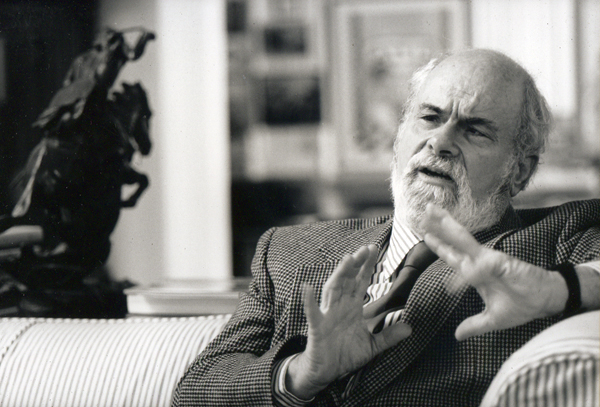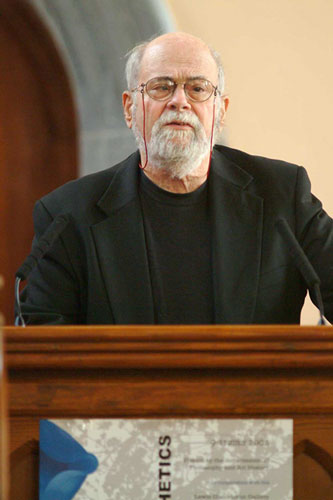Arthur Danto
Arthur Coleman Danto ( born January 1, 1924 in Ann Arbor, Michigan, † October 25, 2013 in New York) was an American philosopher and art critic. Danto, one of the few representatives of analytical philosophy with extensive knowledge of continental European philosophy. His range of topics covered in particular the areas of aesthetics, art theory, philosophy of history, philosophy of mind, action theory and mysticism. In his work, the influence of Hegel, Nietzsche, Sartre and Wittgenstein show.
Career
Danto took off in 1945 to study painting and history at Wayne State University in Detroit with the goal to become an artist. After he had there made a Bachelor's degree in 1948, he began in 1948 his philosophy studies at Columbia University in New York, where he reached the 1949 Masters. With a Fulbright scholarship he was able to study in 1949-50 in Paris with Merleau -Ponty. In 1951 he returned to the U.S. to teach at Columbia University, where he remained until his retirement in 1992. He received his doctorate in 1952 at John Herman Randall, Jr. about Historical Judgement for Ph. D. and was appointed professor in 1966. In 1983 he was president of the American Philosophical Association and from 1989 to 1990 president of the American Society for Aesthetics. Since 1965 he was one of the editors of the Journal of Philosophy and was from 1984 to 2009 as an art critic for the weekly magazine The Nation operates. He was also co-editor of Naked Punch Review and wrote for the Art Newspaper Artforum.
Work
In his books Danto covers a wide breadth of philosophical topics. He studied in Analytic Philosophy of History (1965 ) methodological problems of historical science. With the works of Nietzsche as Philosopher (1965 ) and Jean -Paul Sartre (1975 ) attempted Danto rehabilitation of these two authors within the analytical philosophy. Since the 1980s, Danto shifted entirely to the Philosophy of Art, where he showed an increasing interest in the historical and plant-specific details. In his art major philosophical work The Transfiguration of the Commonplace ( 1981) and in his subsequent essay collections The Philosophical Disenfrachisement of Art ( 1986) and Beyond the Brillo Box ( 1992) Danto tries to analyze the representational character of works of art. Its been published in 1984 in the weekly magazine Nation art reviews were published together with art philosophy additions in three anthologies: The State of the Art (1987 ), Encounters & Reflections: Art in the Historical Present (1990) and Embodied Meanings: Critical Essays and Meditations (1994 ).
Theory of history
In his first work Analytic Philosophy of History ( 1965) Danto is concerned with methodological issues of historiography. He fertilized it dramatically methods discussions of the discipline in the 1960s and 1970s.
Danto is opposed philosophies of history who want to make statements about the whole of the story. The history of science deals with past events, allowing generally not a projection into the future. It links in narrative fashion ( narrative sentences ) beginning and end of stories to each other ( "history tells stories" ) and is thus conceptually distinct from a theory, formulated in the law-like hypotheses to explain the events from given premises or allow to predict. The narrative organization of stories is principally guided by the subjective interests of the historian and never congruent with its object.
Theory of Action
Danto has given its concept of base action, he sets out in detail in his book Analytical Philosophy of Action ( 1973), a major impetus for the detailed analysis of the concept of action. Then based actions have a meaning similar basis sets in the theory of knowledge for actions. The existence of actions presupposes the existence of basic actions. Mediated actions need to not " by - that" to get into an infinite regress of relations that contain last acts that are not themselves taught. Such base acts to exist only in the context of the complete actions. We can reach them just by subtraction of features of the complete action, in which they are embedded.
Danto identifies basic acts which always express themselves in body movements, with their corresponding neurophysiological processes. This body movements are not themselves caused by acts of will. There are on the one hand, Danto not the person who performs an act of will, and on the other hand his actions, but we "are our actions and one with the influence relevant areas of our body."
Art Theory
The starting point of Danto's theory of art is the question: what makes an object a work of art? For the answer to which he coined the term Artworld (German art world). In a later article, he defined the art world as a " loose association of persons" who enter into a " discourse of reason " which " transmits the status of art on things." A work of art as such only gained access to the art world through art-theoretical interpretation: "Art is a thing whose existence is dependent on theories ". Its status as a "work of art " will be awarded to an object by the interpretation which makes reference to " over- something - be ( aboutness ) ". As a work of art, it is because it is a symbolic expression embodies a meaning. In contrast to George Dickie, "the founder of the institutional theory of art," Danto insists that the only ( as Dickie ) gives " institutionalized discourse of reason " and not an " authorization Elite " an object the status of art. Legitimate member of the institutionally authored art world is, who has access to the discourse.
Danto's thesis was on his own stories triggered by a visit in 1964 at New York's Stable Gallery, which had Andy Warhol's Brillo Boxes issued. He evaluated the Brillo Box exhibition as a " key experience suitable to revolutionize the whole theory of art: Warhol and other Pop Art artists had been shown to be of two objects that looked exactly the same, one a work of art and the other none could. "
Awards (selection)
Writings
- Analytic Philosophy of History, Cambridge University Press, Cambridge 1965 German: Analytical Philosophy of History, translated by Jürgen Behrens, Suhrkamp, Frankfurt 1974, ISBN 978-3-518-06373-6.
- German: Nietzsche as a philosopher. Wilhelm Fink Verlag, Munich 1998, ISBN 978-3-7705-3230-8.
- German: Mysticism and morality - Eastern and Western thought .. Wilhelm Fink Verlag, Munich 1999, ISBN 978-3-7705-3271-1.
- German: Analytical philosophy of action, translated by Ulrich Vogel, Scriptor Verlag, Königstein i Ts 1979, ISBN 3-589-20675-6.
- German: Jean -Paul Sartre. Steidl, Göttingen 1986
- German: The transfiguration of the commonplace, translated by Max Looser, Suhrkamp, Frankfurt 1984, ISBN 3-518-06427-4.
- German: The philosophical disenfranchisement of art, translated by Karen Lauer, Wilhelm Fink Verlag, Munich 1994, ISBN 978-3-7705-2825-7.
- German: stimulus and reflection. Wilhelm Fink Verlag, Munich 1994, ISBN 978-3-7705-2876-9.
- German: Art after the end of art. Wilhelm Fink Verlag, Munich 1996, ISBN 978-3-7705-3046-5.
- German: Understanding the World - Basic concepts of philosophy. Wilhelm Fink Verlag, Munich 1999, ISBN 978-3-7705-3071-7.
- German: The survival of the art. Wilhelm Fink Verlag, Munich 2000, ISBN 978-3-7705-3231-5.










